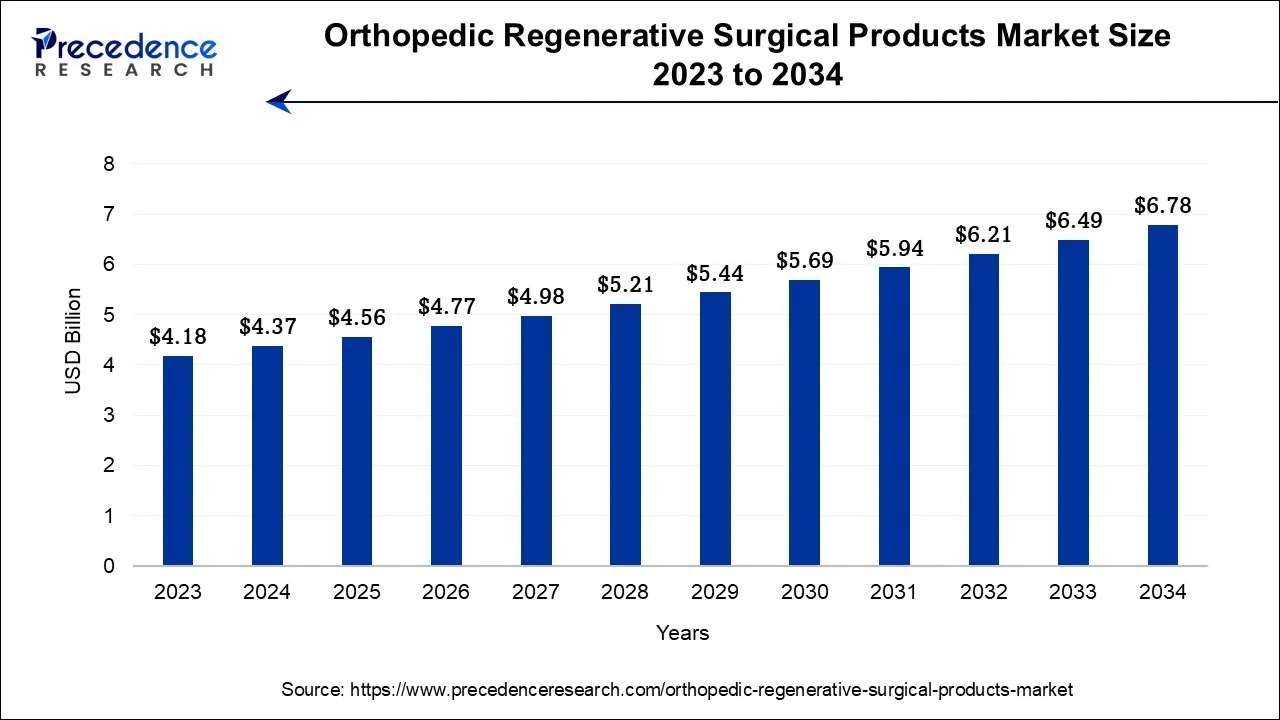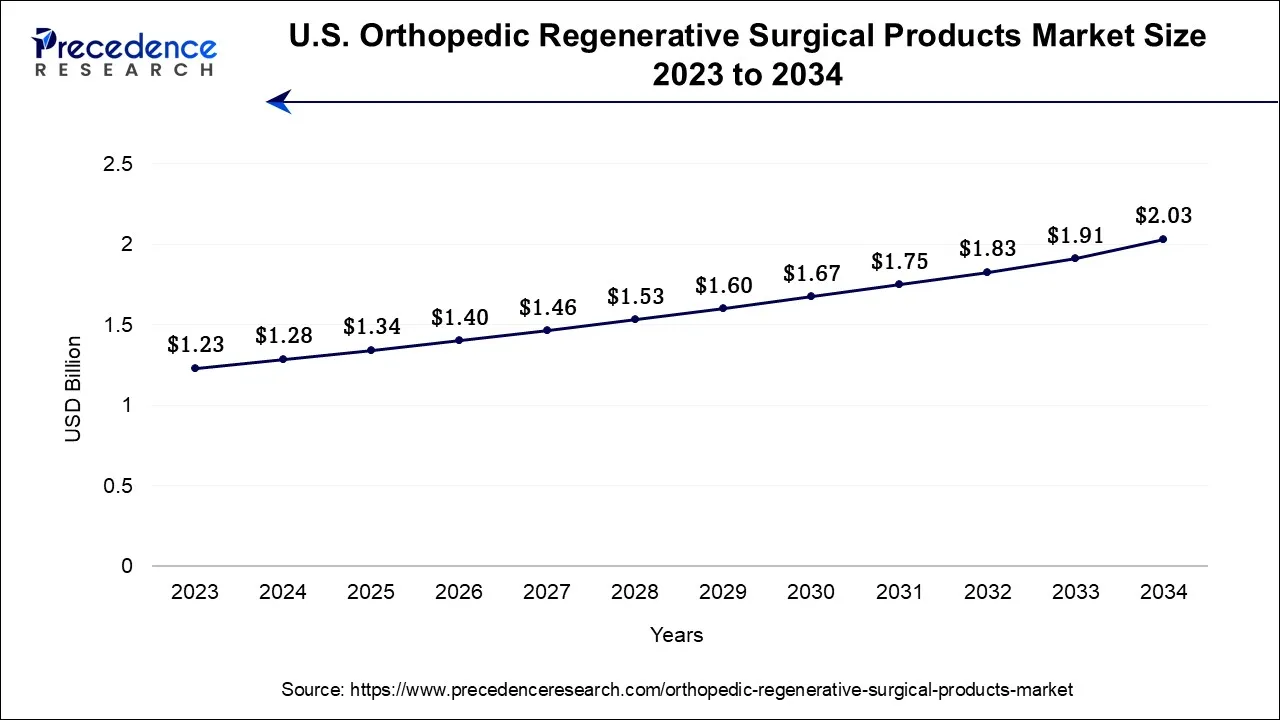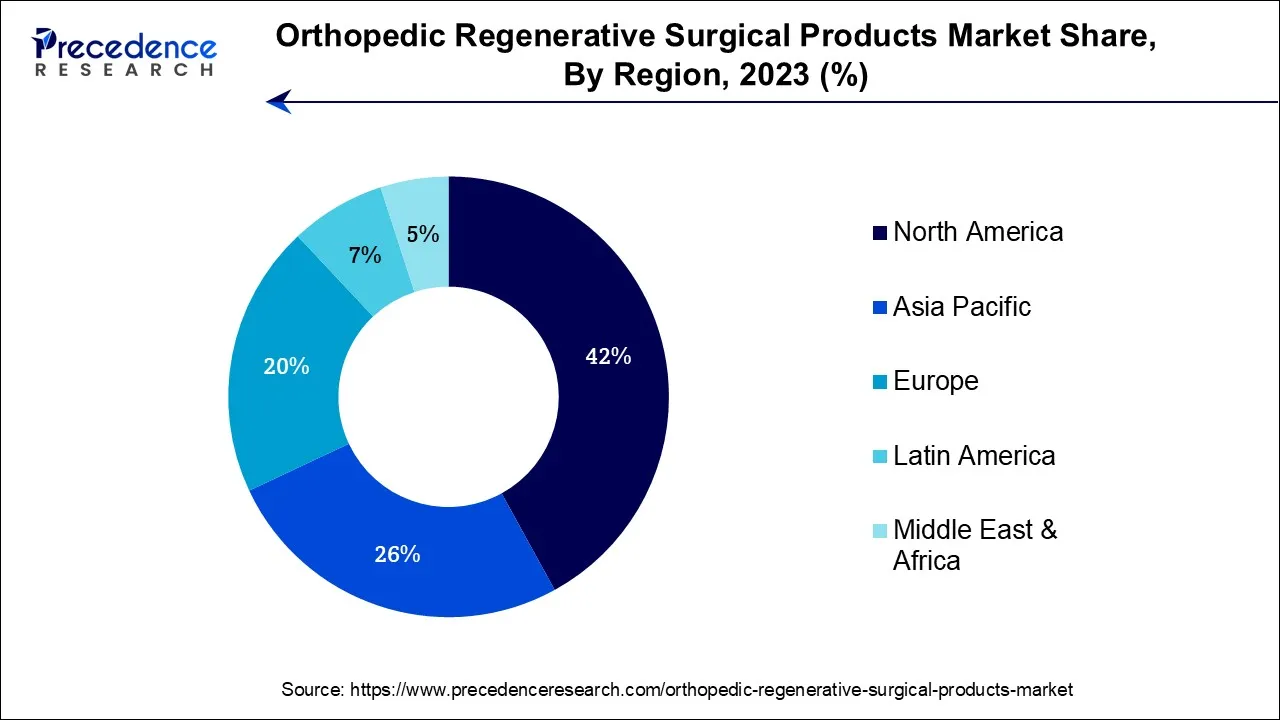January 2025
The global orthopedic regenerative surgical products market size is calculated at USD 4.37 billion in 2024, grew to USD 4.56 billion in 2025, and is predicted to hit around USD 6.78 billion by 2034, poised to grow at a CAGR of 4.49% between 2024 and 2034. The North America orthopedic regenerative surgical products market size accounted for USD 1.84 billion in 2024 and is anticipated to grow at the fastest CAGR of 4.61% during the forecast year.
The global orthopedic regenerative surgical products market size is expected to be valued at USD 4.37 billion in 2024 and is anticipated to reach around USD 6.78 billion by 2034, expanding at a CAGR of 4.49% over the forecast period from 2024 to 2034.

The U.S. orthopedic regenerative surgical products market size is accounted for USD 1.28 billion in 2024 and is projected to be worth around USD 2.03 billion by 2034, poised to grow at a CAGR of 4.69% from 2024 to 2034.

The market for orthopedic regenerative surgical products is dominated by North America, and this dominance is anticipated to continue for the forecast period. The market is experiencing robust growth, driven by several key factors that converge to create a favorable environment for its expansion. This market focused on regenerative solutions for musculoskeletal conditions, has witnessed a surge in demand and innovation.
The region's passion for sports has resulted in a high rate of sports-related injuries, particularly among athletes. Regenerative products like PRP injections have gained popularity for their ability to accelerate healing and reduce downtime, making them attractive to professional athletes and the general population. The presence of important players, the technologically advanced healthcare infrastructure in Canada and the United States, and the rising senior population are reasons for the region's supremacy. Statistics from 2022 show that 18.8% of Canada's population was 65 years or older.

Asia Pacific has One of the Largest and Fastest-Growing Market
The demand for orthopedic regenerative surgical products in Asia Pacific is driven by a convergence of several key factors. The aging population in few countries is a significant driver for the market in the region. As people age, orthopedic conditions such as osteoarthritis and degenerative joint diseases increase. Regenerative surgical products offer hope for improved mobility and pain relief, making them increasingly sought after by the elderly.
The growing awareness of regenerative medicines potential benefits fuels demand. Patients and healthcare providers in the region are becoming more informed about regenerative treatments, leading to greater adoption. This awareness is often bolstered by success stories and positive outcomes from patients undergoing regenerative procedures. Favorable regulatory environments in several Asian nations encourage market expansion by making regenerative products simpler to access. These elements combine to fuel demand for orthopedic regenerative surgical products in Europe, with growth prospects as the industry develops and becomes more widely accepted.
The growth of the orthopedic regenerative surgical products market in Asia Pacific is also anticipated due to advancements in medical technology and increasing healthcare investments in countries like China and India. This is further bolstered by a growing awareness of non-surgical alternatives to traditional orthopedic procedures.
Collaborations between local healthcare providers and international orthopedic companies are expanding the availability of orthopedic regenerative products in the region. Regulatory approvals and clinical trials also pave the way for more treatment options. Moreover, the desire for quicker recovery times, reduced hospital stays, and improved patient outcomes propels the adoption of regenerative surgical products among patients and healthcare providers.
Regenerative orthopedics are generally referred to lessen musculoskeletal pain and discomfort and speed up the recovery from orthopedic disorders such as tears to the tendon, ligament, bone, muscle, spinal disc, knee meniscus, cartilage, or other musculoskeletal tissues. One of the main causes of disability in the older population worldwide is a variety of orthopedic diseases, including osteoarthritis. Thus, in the years to come, demand prospects in the worldwide orthopedic regenerative surgical products market are anticipated to be driven by growth in the older population across key regions.
A number of market trends are gaining traction, including the rising demand for less invasive orthopedic surgeries using regenerative materials from patients and healthcare professionals, as these techniques frequently lead to faster healing.
Key drivers of the orthopedic regenerative surgical products market expansion include the rising prevalence of orthopedic disorders, including arthritis, advancing technology, and an increase in orthopedic operations. According to reports from the National Health Interview Survey (NHIS), by 2040, 78.4 million (25.9%) US adults 18 and older are anticipated to have arthritis that has been officially diagnosed by a doctor.
| Report Coverage | Details |
| Market Size in 2024 | USD 4.37 Billion |
| Market Size by 2034 | USD 6.78 Billion |
| Growth Rate from 2024 to 2034 | CAGR of 4.49% |
| Largest Market | North America |
| Fastest Growing Market | Asia Pacific |
| Base Year | 2023 |
| Forecast Period | 2024 to 2034 |
| Segments Covered | By Product and By Application |
| Regions Covered | North America, Europe, Asia-Pacific, Latin America, and Middle East & Africa |
Orthopedic regenerative surgical products market expansion has been significantly accelerated by technological improvements. By offering safer and less intrusive treatments, these advances have changed how orthopedic surgery is practiced. Significant advancements have been made in regenerative medicine recently. Biologics, tissue engineering, and stem cell therapy are now recognized as essential to regenerative surgical products. These innovative technologies have completely transformed how orthopedic diseases are treated.
For instance, stem cell therapy enables patients to induce tissue repair and regeneration using their stem cells. This tailored strategy may improve results while lowering the likelihood of failure. Due to tissue engineering techniques, bioactive scaffolds and grafts that resemble natural tissues have been created. These scaffolds are crucial for mending injured tendons, ligaments, and joints because they may enable tissue growth and regeneration. Additionally, biologics like growth factors and cytokines have been used to activate cellular tissue healing.
Improvements in surgical methods have made it possible for minimally invasive operations. For instance, arthroscopy allows surgeons to examine and treat joint problems using tiny incisions, minimizing damage to the nearby tissues. This reduces the chance of infection and complications while also hastening recovery timeframes.
The market for orthopedic regenerative surgical products confronts considerable regulatory obstacles due to the complexity of these therapies and the necessity to ensure their efficacy. These difficulties result from regenerative goods frequently incorporating unique biological components and cutting-edge techniques that need meticulous control. Regulatory agencies, like the European Medicines Agency (EMA) and the U.S. Food and Drug Administration (FDA), are essential in guaranteeing the efficacy and safety of medical products. These organizations struggle to create suitable regulatory frameworks for regenerative surgical goods that can consider the special features of these treatments.
Regenerative products frequently need to go through a protracted and stringent approval process. To prove safety and efficacy, comprehensive preclinical and clinical testing is required. These tests might be expensive and time-consuming, which would postpone the release of regenerative products. Thus, such regulatory hurdles are observed to create a restraint for the market.
Precision medicine, or personalized medicine, is a revolutionary method of providing healthcare that adapts medical decisions and treatments to unique patient features, such as genetics, way of life, and environmental factors. Personalized medicine is altering how one approaches treatment and has the potential to greatly enhance patient outcomes in the context of orthopedic regenerative surgical devices.
In orthopedics, genetic profiling is a crucial component of customized medicine. Healthcare professionals can uncover genetic predispositions to orthopedic disorders or judge patients' appropriateness for particular regeneration treatments by looking at their genetic composition. For instance, understanding a patient's genetic risk factors can help clinicians decide whether to pursue stem cell therapy or a conventional joint replacement in cases of osteoarthritis. Orthopedic surgeons can tailor regenerative treatment regimens depending on the unique patient profiles. For instance, the surgeon may suggest a different strategy or combination of medicines to speed up the healing process if the patient carries a certain gene mutation linked to poor tissue healing.
The visco supplements segment held the largest share in 2023 and is predicted to continue to rule throughout the projected period. Viscosupplements, which are frequently used to treat osteoarthritis, have grown in popularity for a number of reasons. As the world's population ages, osteoarthritis is more common, which raises the demand for therapies like viscosupplements. People are more likely to seek medical advice, including viscosupplements, due to increased knowledge of osteoarthritis and available treatment alternatives. They are an appealing non-surgical solution for controlling osteoarthritis pain for people who prefer to avoid surgery. Viscosupplements' efficacy has been increased due to ongoing research and development in the sector and better formulations. Many players operating in the market are forming strategies to maintain a strong foothold.
In the global market, the allografts segment has the fastest growth rate. The market for orthopedic regenerative surgical products has expanded significantly in recent years, and allografts have been a major factor in this rise. The rising use of allografts in orthopedic regeneration operations is being fueled by a number of factors, such as advancements in tissue processing and preservation techniques that have improved the safety and efficacy of allografts. These developments have reduced the risk of disease transmission and graft failure, making allografts a more viable option for surgeons and patients.
The demand for allografts has increased due to the shift toward minimally invasive surgical procedures. Allografts can be utilized to restore and regenerate injured tissues during various minimally invasive procedures, such as arthroscopy and endoscopy. These less invasive methods are frequently chosen by patients since they frequently lead to speedier healing times and less post-operative pain. In August 2022, orthopedic surgeons at the University National Hospital carried out the first meniscal transplant in Scotland, who transplanted donor cartilage into the patient's knee.
The joint reconstruction segment had the dominating share in 2023. There are a number of important aspects that can be linked to the rising demand for joint reconstruction operations. The demand is growing as people lead more active lifestyles. Nowadays, more people participate in sports and other physical activities, which might result in joint injuries that need surgery for proper healing. In addition, people are more concerned with health and well-being and frequently seek joint reconstruction to keep an active lifestyle even after joint-related accidents or degeneration.
The cartilage and tendon repair segment is predicted to grow fastest worldwide. Medical technology and research developments have made the development of more potent regeneration products possible. This comprises applying biocompatible components that facilitate tissue regeneration and repair, such as stem cells and scaffolds. Additionally, improved imaging techniques allow for more accurate diagnosis and monitoring of musculoskeletal conditions, enabling surgeons to better tailor their treatment plans.
Market Segmentation
By Product
By Application
By Geography
For inquiries regarding discounts, bulk purchases, or customization requests, please contact us at sales@precedenceresearch.com
No cookie-cutter, only authentic analysis – take the 1st step to become a Precedence Research client
January 2025
January 2025
December 2024
August 2024